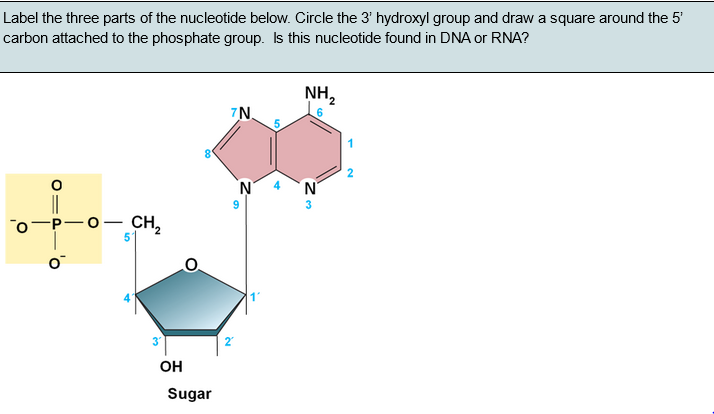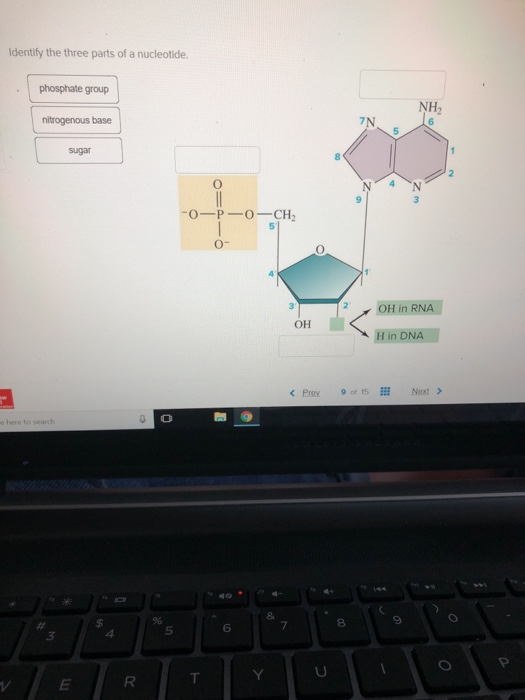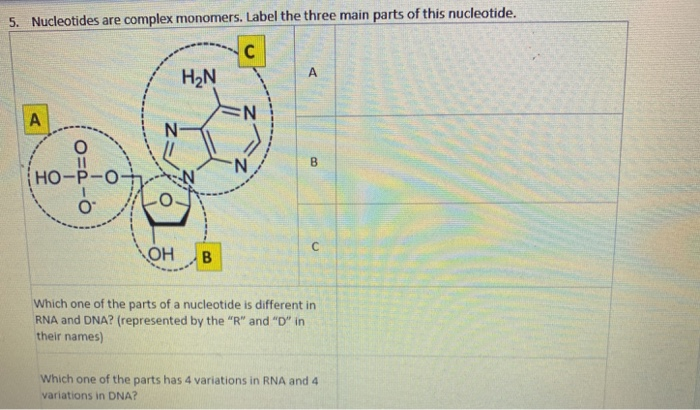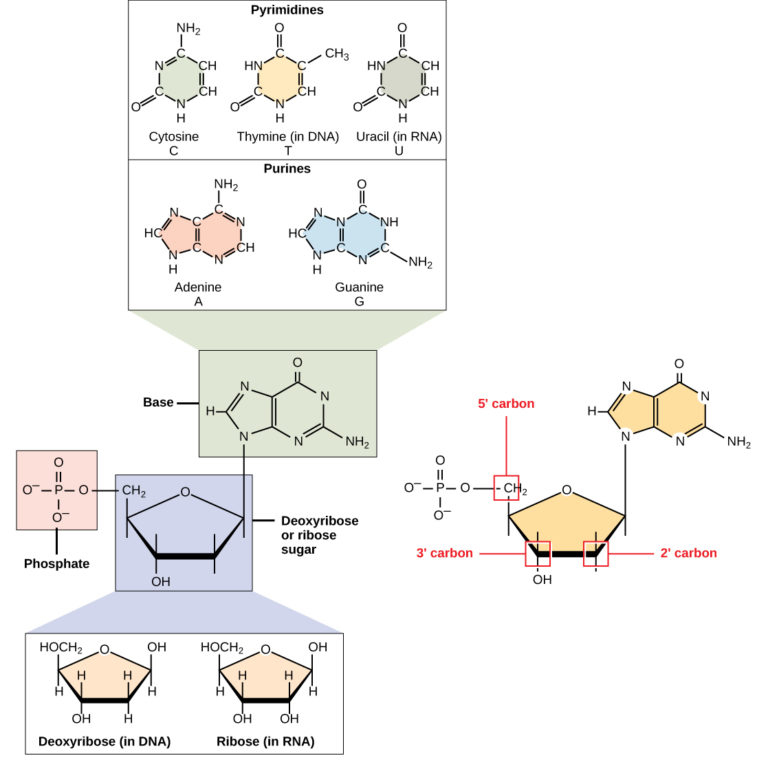40 what are the three parts in a nucleotide?
What are the three parts of a nucleotide? | albert.io (2022) What is a nucleotide?Deoxyribonucleic acid, affectionately known asADN, is a molecule in the form of a double helix, responsible for storing genetic information in the cells of all living organisms. ... Figure 2: The chemical assembly of the three parts of the nucleotide, the phosphate (blue box), the nitrogenous base (red box) and the pentose ... What are the three parts of a nucleotide? - Toppr Ask >> What are the three parts of a nucleotide. Question . What are the three parts of a nucleotide? Hard. Open in App. Solution. Verified by Toppr. Figure shows adenine structure. Nucleotide shown in the figure is divided into nitrogen containing base, sugar backbone and phosphate group.
Why are the three parts of a nucleotide? - Daily Justnow nucleotide -> composed of three parts: nitrogenous base, five-carbon sugar (pentose), and phosphate group. What are the three components of a nucleotide Brainly? Answer: There are just 3 components of nucleotide: nitrogenous base, deoxyribose (sugar) and phosphate group . What are the 3 components of DNA nucleotide? Nucleotide Structure

What are the three parts in a nucleotide?
Why are the three parts of a nucleotide? - ooth.qc.to The three parts of a nucleotide are connected via covalent bonds. The nitrogenous bases bonds to the first or primary carbon atom of the sugar. The number 5 carbon of the sugar bonds to the phosphate group. A free nucleotide may have one, two, or three phosphate groups that attach as a chain to the sugar's 5-carbon. Why are the three parts of a nucleotide? Explained by FAQ Blog Which of the 3 parts of a nucleotide helps determine the code or sequence of a gene? Each nucleotide contains one of four nitrogen-containing bases: adenine (A), thymine (T), cytosine (C) and guanine (G). The sequence of these bases constitutes the genetic code - that specifies the order and number of amino acids in a protein. Nucleotide - Definition, Structure (3 Parts), Examples & Function A nucleotide is an organic molecule that is the building block of DNA and RNA. They also have functions related to cell signaling, metabolism, and enzyme reactions. A nucleotide is made up of three parts: a phosphate group, a 5-carbon sugar, and a nitrogenous base. The four nitrogenous bases in DNA are adenine, cytosine, guanine, and thymine.
What are the three parts in a nucleotide?. What are the three part of the nucleotide? - Answers The DNA nucleotide consists of three parts: a phosphate group, a 5-carbon sugar, and a nitrogenous base. The portion of the nucleotide that contains a negative charge is the phosphate group. What are the 3 common parts of a nucleotide? - WisdomAnswer The three parts of a nucleotide are connected via covalent bonds. The nitrogenous bases bonds to the first or primary carbon atom of the sugar. The number 5 carbon of the sugar bonds to the phosphate group. A free nucleotide may have one, two, or three phosphate groups that attach as a chain to the sugar's 5-carbon. ... Nucleotide - Genome WebDec 08, 2022 · A nucleotide is the basic building block of nucleic acids (RNA and DNA). A nucleotide consists of a sugar molecule (either ribose in RNA or deoxyribose in DNA) attached to a phosphate group and a nitrogen-containing base. The bases used in DNA are adenine (A), cytosine (C), guanine (G) and thymine (T). In RNA, the base uracil (U) takes … Guide design resources — Zhang Lab WebThank you to the thousands of users who visited our guide design tool over the past five years. We recently shut down crispr.mit.edu, but there are many other guide design tools available that we hope you will find helpful.
What Are The Three Parts Of A Nucleotide | Jacks Of Science The three parts of a nucleotide are the phosphate group, the sugar group, and the nitrogenous base. The phosphate group is bonded to the sugar group, and the sugar group is bonded to the nitrogenous base. What are the 3 components of DNA nucleotide? The nitrogenous base is what provides the identity of each nucleotide. What are the parts of the nucleotide? - Answers The three parts of a nucleotide is the deoxyribose, the nitrogen base, and the phosphate group. What 3 parts make a nucleotides? The phosphate group is part of the nucleotide. Open Access Journals | Scientific Conferences and Events … WebWe are an Open Access publisher and international conference Organizer. We own and operate 500 peer-reviewed clinical, medical, life sciences, engineering, and management journals and hosts 3000 scholarly conferences per year in the fields of clinical, medical, pharmaceutical, life sciences, business, engineering and technology. What Are the Three Main Parts of a Nucleotide? - byjus.com Three Parts of Nucleotide Sugar The sugar component of the nucleotides is a five-carbon sugar. Deoxyribose or 2-deoxyribose is the five-carbon sugar that is found in DNA, whereas ribose is found in RNA. The primary difference between the two sugars is the replacement of hydroxyl group by hydrogen at the 2' position in deoxyribose.
Google Scholar Citations WebGoogle Scholar Citations lets you track citations to your publications over time. what are 3 parts of a nucleotide? - Brainly.com The three parts of a nucleotide are: - A phosphate group. - Nitrogenous base. - Five-carbon atoms. Explanation of 3 Parts of a Nucleotide and Nucleotide Examples - HoneyReads Within the 3 parts of a nucleotide, there are five types of nucleotide bases which are: Adenine (A), Cytosine (C), Guanine (G), Thymine (T) and Uracil (U). When they are combined with sugar, they form nucleotide adenosine, cytidine, guanosine, thymidine, and uridine. 1. Adenine Management of HIV/AIDS - Wikipedia WebNucleoside/nucleotide reverse-transcriptase inhibitors. Nucleoside reverse-transcriptase inhibitors (NRTI) and nucleotide reverse-transcriptase inhibitors (NtRTI) are nucleoside and nucleotide analogues which inhibit reverse transcription. HIV is an RNA virus, so it can not be integrated into the DNA in the nucleus of the human cell unless it ...
GenBank Sample Record - National Center for Biotechnology Information WebJun 21, 1999 · Number of nucleotide base pairs (or amino acid residues) in the sequence record. In this example, the sequence length is 5028 bp. ... Protein IDs consist of three letters followed by five digits, a dot, and a version number. If there is any change to the sequence data (even a single amino acid), the version number will be increased, but the ...
What Are the Three Parts of a Nucleotide? - Science Notes and Projects The three parts of a nucleotide are the base, the sugar, and the phosphate. Nucleotides are the building blocks of DNA (2′-deoxyribonucleic acid) and RNA (ribonucleic acid). DNA and RNA code genetic information, transport energy throughout cells, and serve as cell signaling molecules.
Deoxyribonucleic Acid (DNA) Fact Sheet - Genome.gov WebAug 24, 2020 · DNA is made of chemical building blocks called nucleotides. These building blocks are made of three parts: a phosphate group, a sugar group and one of four types of nitrogen bases. To form a strand of DNA, nucleotides are linked into chains, with the phosphate and sugar groups alternating.
What are the three parts of a nucleotide? - Answers The three parts of a nucleotide is the deoxyribose, the nitrogen base, and the phosphate group. Does a nucleotide have four parts? No. A nucleotide has three parts: a phosphate group, a ...
What are the three parts of a nucleotide? 🇧🇷 albert.io (2022) What is a nucleotide?Deoxyribonucleic acid, affectionately known asDNS, is a molecule in the form of a double helix responsible for storing genetic information in the cells of all living organisms. ... Figure 2: The chemical structure of the three parts of the nucleotide, the phosphate (blue box), the nitrogenous base (red box) and the pentose ...
What are the three parts of a nucleotide? Flashcards | Quizlet What are the three parts of a nucleotide? Phospate, sugur, nitrogen base Nucleotide basic unit surgery in DNA deoxylibonuelic hydrogen bonds hold DNA together covalent bond is sharing of electrons ionic is the attraction between 2 ions 4 nitrogen bases cytosine, thymine, adenine, guanine DNA is a polymer
What are the 3 parts of a nucleotide look like? - TeachersCollegesj What forms A nucleotide? Nucleotide A nucleotide is the basic building block of nucleic acids. A nucleotide consists of a sugar molecule (either ribose in RNA or deoxyribose in DNA) attached to a phosphate group and a nitrogen-containing base. The bases used in DNA are adenine (A), cytosine (C), guanine (G), and thymine (T).
Which is a part of a nucleotide - signalduo.com The second part of a nucleotide is the phosphate, which differentiates the nucleotide molecule from a nucleoside molecule. This phosphate is important in the formation of phosphodiester bonds, which link several nucleotides in a linear fashion. The third part of a nucleotide is the pentose (5 carbon) sugar.
What Are The 3 Parts Of A Nucleotide? - Cooking Tom There are three major components to a nucleotide, and they are the backbone, deoxyribose sugar, and a nitrogenous base. The backbone is a repeating chain of deoxyribose sugars. The deoxyribose sugar is made up of five carbon atoms, including the glycoside bond. The nitrogenous base is made up of an amine and a hydrophobic base.
What is a nucleotide and what are its 3 components? Within the 3 parts of a nucleotide, there are five types of nucleotide bases which are: Adenine (A), Cytosine (C), Guanine (G), Thymine (T) and Uracil (U). When they are combined with sugar, they form nucleotide adenosine, cytidine, guanosine, thymidine, and uridine. 1. Adenine Which is nucleotide has a double ring structure like adenine?
Primer designing tool - National Center for Biotechnology Information WebEnter a list of space separated nucleotide positions. This requires that the left or the right primers to span a junction that is just 3' of any such positions. For example, entering "50 100" would mean that the left or the right primers must span the junction between nucleotide position 50 and 51 or the junction between position 100 and 101 ...
Nucleotide - Wikipedia WebA nucleotide is composed of three distinctive chemical sub-units: a five-carbon sugar molecule, a nucleobase (the two of which together are called a nucleoside), and one phosphate group.With all three joined, a nucleotide is also termed a "nucleoside monophosphate", "nucleoside diphosphate" or "nucleoside triphosphate", depending on …
3 Parts of a Nucleotide and How They Are Connected - ThoughtCo Nucleotides in DNA and RNA Both deoxyribonucleic acid (DNA) and ribonucleic acid (RNA) are made up of nucleotides which consist of three parts: Nitrogenous Base Purines and pyrimidines are the two categories of nitrogenous bases. Adenine and guanine are purines. Cytosine, thymine, and uracil are pyrimidines.
Home Page: American Journal of Obstetrics & Gynecology WebAug 04, 2021 · AJOG's Editors have active research programs and, on occasion, publish work in the Journal. Editor/authors are masked to the peer review process and editorial decision-making of their own work and are not able to access this work in the online manuscript submission system.
What are the Three Parts of a Nucleotide? | Albert.io Mar 01, 2022 · The assembly of nucleotides (1) differentiates them from nucleosides, which do not contain a phosphate group (in the blue box); (2) allows the nucleotide to connect to other nucleotides when the nitrogenous base forms a hydrogen bond with another nucleotide’s nitrogenous base; as well as (3) allows the phosphate to form a phosphodiester bond ...
What are the 3 main parts of a nucleotide? [Expert Review!] A nucleotide is made up of three parts: a phosphate group, a 5-carbon sugar, and a nitrogenous base. The four nitrogenous bases in DNA are adenine, cytosine, guanine, and thymine. What are the 3 types of nucleic acids? The most common types of nucleic acids are: deoxyribonucleic acid (DNA) ribonucleic acid (RNA) messenger RNA (mRNA)
Nucleotide - Definition, Structure (3 Parts), Examples & Function A nucleotide is an organic molecule that is the building block of DNA and RNA. They also have functions related to cell signaling, metabolism, and enzyme reactions. A nucleotide is made up of three parts: a phosphate group, a 5-carbon sugar, and a nitrogenous base. The four nitrogenous bases in DNA are adenine, cytosine, guanine, and thymine.
Why are the three parts of a nucleotide? Explained by FAQ Blog Which of the 3 parts of a nucleotide helps determine the code or sequence of a gene? Each nucleotide contains one of four nitrogen-containing bases: adenine (A), thymine (T), cytosine (C) and guanine (G). The sequence of these bases constitutes the genetic code - that specifies the order and number of amino acids in a protein.
Why are the three parts of a nucleotide? - ooth.qc.to The three parts of a nucleotide are connected via covalent bonds. The nitrogenous bases bonds to the first or primary carbon atom of the sugar. The number 5 carbon of the sugar bonds to the phosphate group. A free nucleotide may have one, two, or three phosphate groups that attach as a chain to the sugar's 5-carbon.




:max_bytes(150000):strip_icc()/what-are-the-parts-of-nucleotide-606385-FINAL-5b76fa94c9e77c0025543061.png)











![SOLVED: 10.Draw tthe ] basic = structure of a nucleotide with ...](https://cdn.numerade.com/ask_images/878be03c166f48539d037a528490ee5c.jpg)




.jpg)










:max_bytes(150000):strip_icc()/GettyImages-1141680075-669f63da324a4cc2a6f8bb0da7d9de7c.jpg)


Komentar
Posting Komentar